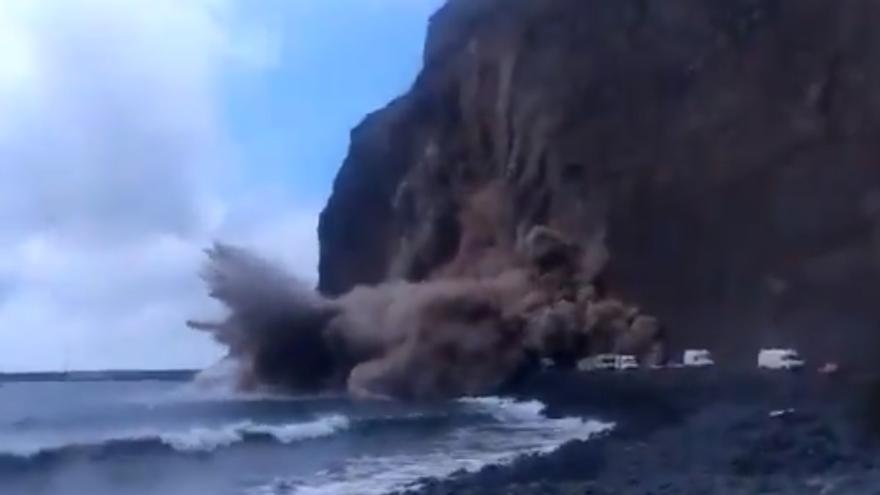
The airing of La Palma on Netflix and its surprising global success have once again highlighted the theory regarding a tsunami or mega-tsunami that could result from the eruption and subsequent collapse of the Cumbre Vieja massif into the ocean. While this scenario remains purely hypothetical for now, the Canary Islands have experienced various tsunamis throughout their history.
Volcanic Eruptions
Tsunamis and megatsunamis have wreaked havoc upon the Canary Islands’ coastlines for millennia. Many of these tsunamis originated from explosive volcanic eruptions followed by landslides that plunged into the sea, displacing water and creating enormous waves. Notably, the megatsunamis associated with the eruptions in Tenerife 170,000 years ago impacted Gran Canaria, Lanzarote, and Tenerife. However, one does not need to look that far back in history to discuss tsunamis in the Canary Islands.
In the last millennium, up to 11 tsunamis have impacted the coasts of the Canary Islands, though some remain undocumented since references related to the Canary Islands are absent in chronicles until the 15th century. A recent study conducted by the Geological and Mining Institute of Spain (IGME) under the auspices of the Higher Council for Scientific Research (CSIC), in collaboration with researchers from the University of La Laguna (ULL) and the Science Museum of Natural History in Tenerife, has detailed all of these occurrences.
Why the Renewed Interest in Tsunamis?
While the theory surrounding a possible megatsunami resulting from the collapse of Cumbre Vieja on La Palma has gained traction in recent years—especially following the volcano’s eruption on September 19, 2021—the research published in Geosciences is not directly linked to this concern.
The study aims to mitigate the potentially destructive impacts of future tsunamis that could threaten the now highly populated Canary coasts. It postulates that the occurrence of tsunamis affecting the Canary Islands is a possibility.
Researchers noted that, historically, there is no evidence indicating that tsunamis have caused human fatalities, partly because the populations in the Canary Islands historically turned their backs on the ocean, both prior to and following the Conquest. The reasons for the ancient Canarians’ apprehension towards the sea remain uncertain, but their inland settlements can likely be attributed to the threat of pirate incursions.
Chronology of the Eight Documented Tsunamis in the Canary Islands
Despite the presence of historical references suggesting tsunamis may have impacted the Canary Islands, as well as evidence of their effects in sedimentary layers on certain islands, only eight have been officially documented to date. The details regarding the eight tsunamis outlined below derive from chronicles in some cases and measurement devices in others. Several of these instances went unnoticed by the local population, perceived merely as larger-than-normal waves.
- 1 November 1755: This tsunami was triggered by the Lisbon earthquake, recorded at a magnitude of 8.5 mbLg. It devastated the southwestern coasts of the Iberian Peninsula and northern Morocco, even making its way to the Americas, both North and South. Research indicates that “the damage and fatalities it inflicted on the Peninsula’s coasts were so significant that the repercussions felt in the Canary Islands were almost overlooked.” The study recounts that around 9:30 a.m. on 1 November 1755, some residents of Tenerife felt the ground tremble, as the sea simultaneously receded by over a kilometre in both Tenerife and Gran Canaria. Historical accounts suggest its effects were felt across all the islands, with flooding exceeding five metres. In Gran Canaria, the hermitage of La Luz was flooded and swamped with fish.
- 31 March 1761: This event also stemmed from a magnitude 8.5 mbLg earthquake in the southwest of the Iberian Peninsula, felt across Portugal, Spain, and Morocco. Records indicate it reached the southern and western coasts of the Peninsula, the United Kingdom, as well as the Azores, Madeira, the Canary Islands, and Barbados. Its impact on the coast of Tenerife “mirrored the effects reported from the 1755 tsunami,” according to the investigation.
- 7 July 1941: This tsunami was noted by the newspaper La Tarde, which reported three colossal waves inundating the coast of Santa Cruz de Tenerife and San Andrés. The Town Hall building and Maritime Avenue, where the Naval Command was located, succumbed to the flooding. These waves have been linked to a local landslide near the Tenerife capital, as no earthquakes or other extreme wave occurrences were reported on that day.
- 25 November 1941: Shortly after the previous tsunami, an underwater landslide linked to an earthquake measuring 8.3 mbLg near Portugal’s coastline produced a tsunami that reached the Canary Islands. However, it garnered scant attention in the local media due to the lack of reported damage.
- 28 February 1969: A low-intensity tsunami emerged from an earthquake on the Gorringe Bank, a seamount 130 miles west of Portugal, located between the Azores and the Strait of Gibraltar. It was recorded by tide gauges in Santa Cruz de Tenerife, Santa Cruz de La Palma, Las Palmas de Gran Canaria, and Arrecife.
- 17 July 1969: On this day, a minor tsunami of uncertain origin was registered in tide charts in Santa Cruz de Tenerife, in various locations in Portugal, as well as in Casablanca.
- 26 May 1975: Following an earthquake of 7.9 mbLg intensity, occurring 200 kilometres south of the Gloria fault in the Atlantic, a tsunami was produced that was notable in the Azores and recorded by a tide gauge in Gran Canaria.
- 14 November 2020: A significant rockfall along the coast of Valle Gran Rey, on La Gomera, created a local tsunami. Videos show the descending stones and the wave generated, which fortunately caused no harm.
















